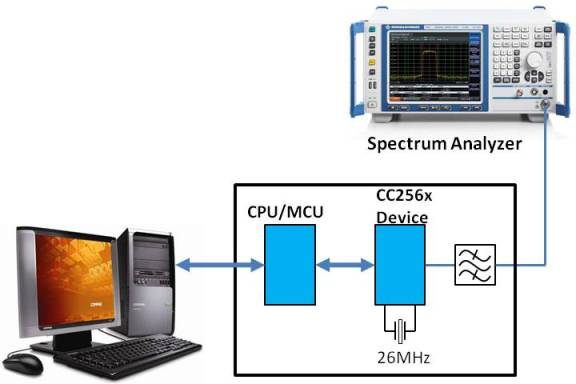SWRA749 September 2022
5.1 Continuous TX
This is a non-packet continuous transmission with either CW (Continuous Wave), GFSK (BR), π/4-DQPSK (2-EDR) or 8DPSK (3-EDR).
The HCI commands to put the device in the constant TX mode (after service pack has been loaded) are:
- HCI_VS_DRPb_Tester_Con_TX 0xFD84, 0x1, 0, 0, 15, 0x00000000, 0x00000000
- HCI_VS_Write_Hardware_Register 0xFF01, 0x0019180c, 0x0101
- HCI_VS_DRPb_Enable_RF_Calibration 0xFD80, 0xFF, 0xFFFFFFFF, 0x01
The parameters for the HCI_VS_DRPb_Tester_Con_TX can be found.
Note: The second and third commands are for internal settings
(HCI_VS_Write_Hardware_Register and HCI_VS_DRPb_Enable_RF_Calibration ). The
HCI_VS_Write_Hardware_Register 0xFF01, 0x0019180c, 0x0101 command is only required for the continuous TX test of
modulated (GFSK, π/4-DQPSK or 8DPSK) signal. This command should be skipped when performing continuous TX test for
CW.
 Figure 5-1 Typical Test Setup for Continuous TX Mode
Figure 5-1 Typical Test Setup for Continuous TX ModeNote:
It is recommended to use the HCITester tool on the PC to send the HCI commands to the CC256x device. The HCITester can be downloaded as part of the Wireless Tools package.